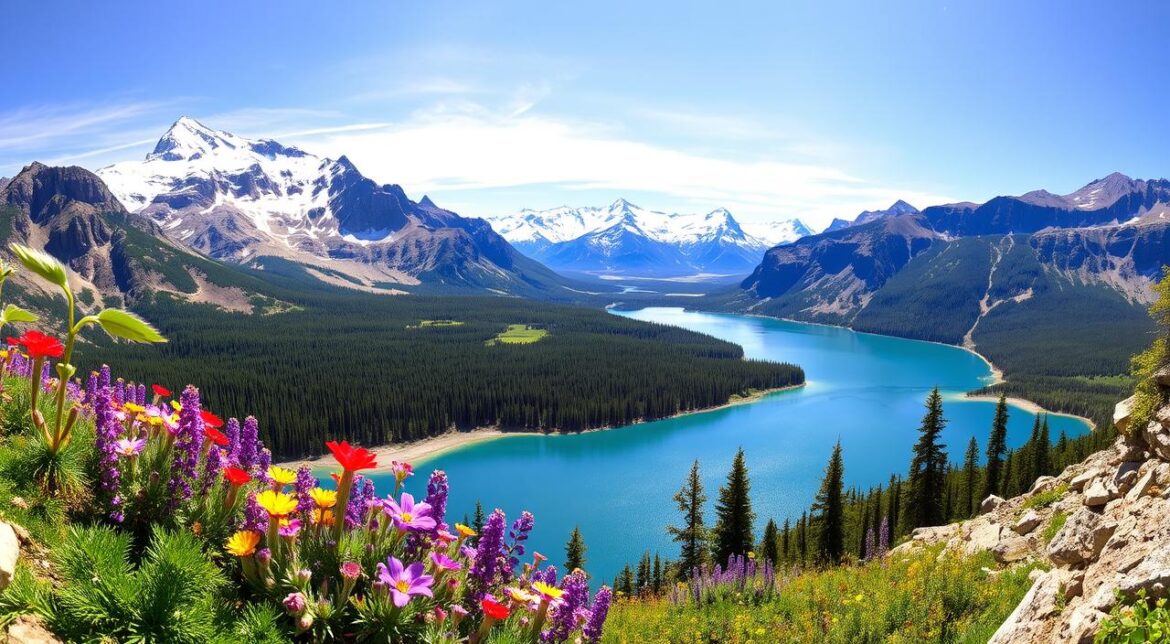Table of Contents
When is the best time to visit Glacier National Park? This vast and stunning wilderness in northwestern Montana offers a unique experience in each of its four distinct seasons. Whether you’re seeking breathtaking scenery, thrilling adventures, or a peaceful escape, the optimal time to visit the park depends on your specific interests and preferences. Explore this comprehensive guide to discover the pros and cons of visiting Glacier National Park during summer, fall, winter, and spring, and learn how to plan the perfect trip to this natural wonder.
What makes Glacier National Park shine in each season, and how can you make the most of your visit? Dive into this guide to uncover the secrets of this majestic landscape and find the perfect time to experience its magic.
Summer: Peak Season for Glacier National Park
Summer, from July through September, is the busiest time at Glacier National Park. The weather is warm and sunny, with temperatures in the 60s to 80s Fahrenheit. All park facilities, roads, and trails are open, offering a wide range of activities like hiking and wildlife viewing.
Crowds and Higher Prices
But, the summer months also bring more visitors. This means bigger crowds and higher prices for places to stay and services. Glacier National Park welcomes up to three million visitors each year, with July and August being the busiest.
Even with the crowds, summer is still a favorite time to visit. The weather is perfect, and you can enjoy everything the park has to offer. Just be ready for the crowds and plan your trip well to have a great Glacier National Park experience.
Fall: Stunning Golden Larches and Fewer Visitors
When summer fades, Glacier National Park becomes a quiet autumn wonderland. The Western Larch trees, or Tamaracks, turn golden, painting the mountainsides. This golden glow peaks in mid-October, offering a peaceful visit.
With fewer people around, you can fully enjoy the park’s beauty. You’ll see more wildlife as they get ready for winter. It’s a special time to explore and see nature’s show.
Colorful Landscapes and Wildlife Activity
Fall in Glacier National Park is a time of vibrant colors and wildlife. The cooling weather brings out the aspen and cottonwood trees’ autumn colors. This creates a stunning view.
It’s also a great time to see wildlife. Animals like elk, bighorn sheep, and grizzly bears are more active. They’re looking for food before winter. You might even see a wolverine on the trails.
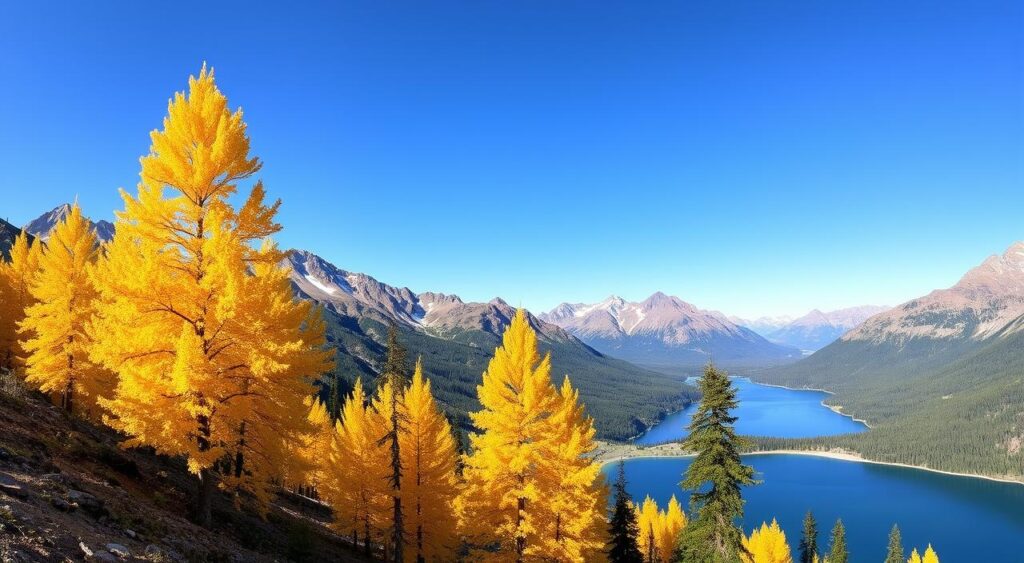
Winter: Solitude and Unique Snow Adventures
Visiting glacier national park in winter, from December to February, is a serene experience. The park is covered in snow, and it’s less crowded. You can enjoy skiing, snowshoeing, and exploring the quiet beauty.
About 25 states are seen in glacier national park in winter. Only two campgrounds, Apgar Village and St. Mary, are open. Nearby towns like Columbia Falls, Whitefish, and Essex have more places to stay and eat.
Winter in glacier national park is a true wonderland. You might see moose, deer, skunks, and snowshoe hares. It’s important to dress warmly to enjoy the snow and quiet.
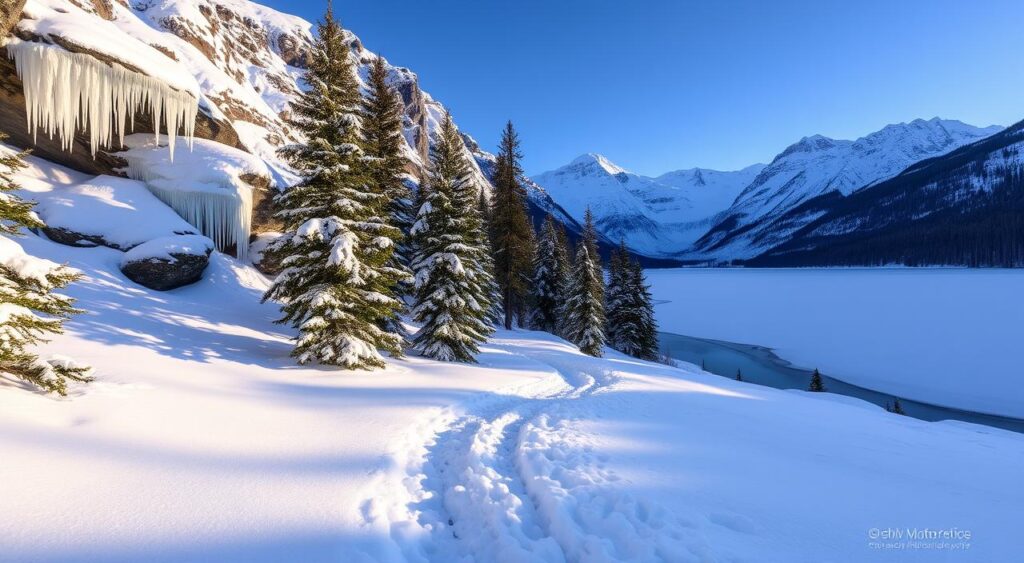
The glacier national park winter experience is unique. It lets visitors enjoy the park’s beauty and exciting snow adventures.
Spring: Biking on the Going-to-the-Sun Road
When the snow melts in Glacier National Park, a special chance comes up. You can bike on the famous Going-to-the-Sun Road before cars can, usually in mid-June. From March to June, the park feels like Europe, with cyclists in the middle of the road. They’re surrounded by breathtaking mountains.
Cycling Before Vehicle Access
Bicyclists are more common in Glacier National Park, wanting to ride the Going-to-the-Sun Road. There’s a fee for biking into the park. Road crews work Monday to Thursday, closing the road for plowing.
Avalanche closures are always in effect, and bikes can’t go on hiking trails or in the backcountry. During peak season, biking is banned from May 24 to September 8 between 3 pm and 6 pm. Only e-bikes under 750 watts are allowed, and they must be pedaled.
Spring Whitewater Rafting
Spring also means great rafting on the Middle Fork of the Flathead River. This river is the park’s southwestern border. It offers exciting rapids and beautiful views for those who dare to try.
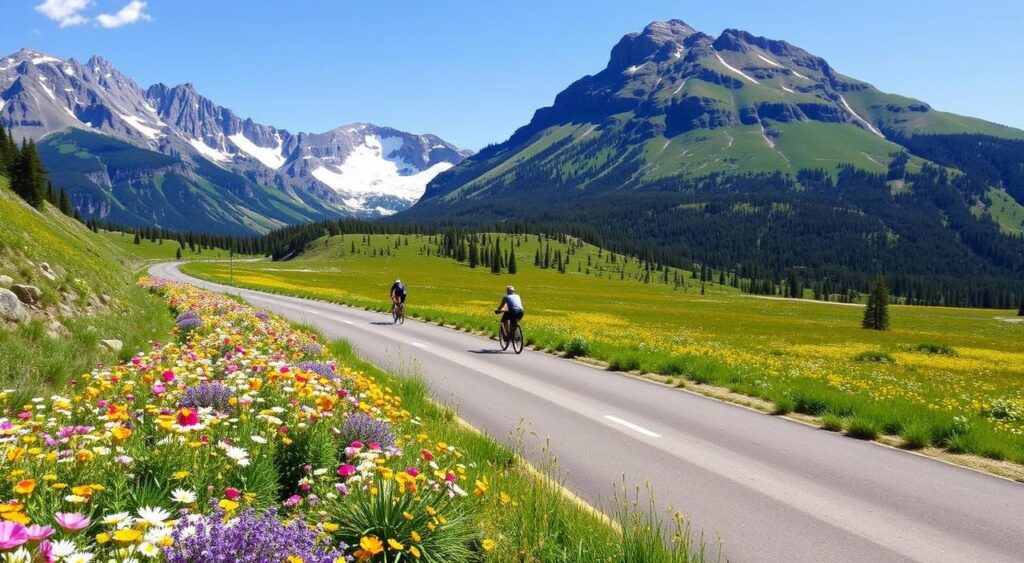
best time to visit glacier national park
Figuring out the best time to visit Glacier National Park involves looking at weather, access, crowds, and activities. Each season has its own perks and downsides. So, think about what you want to do and see to plan the best trip.
Factors to Consider
Weather is a big factor. Summer, especially July and August, is usually the best time. It’s warm and sunny, perfect for exploring trails and enjoying the park’s facilities. But, it’s also the busiest time, with over three million visitors.
For a quieter visit, consider spring or fall. Spring lets you cycle on the Going-to-the-Sun Road early and see wildflowers in bloom. Fall offers golden larches and more wildlife, with fewer people around.
Winter is special too, with snow and activities like snowshoeing. But, some places might be closed or have limited services.
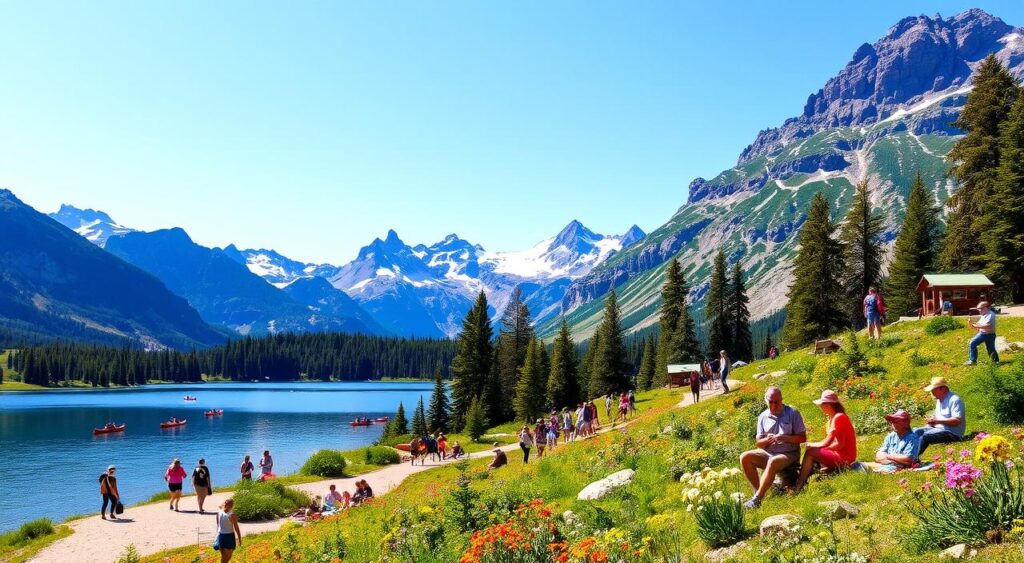
So, the best time for you depends on what you want to do. Think about the weather, crowds, and what’s open to plan your dream trip to this beautiful place.
Hiking in Glacier National Park
Glacier National Park is a dream destination for hikers. It has over 700 miles of trails that take you through breathtaking views. No matter if you’re a seasoned hiker or just starting out, there’s something for everyone here.
Trail Accessibility and Conditions
The trails in Glacier National Park change with the seasons. In summer, the weather is warm and dry, making it the best time to hike. But, spring and fall can bring snow or mud, making trails slippery.
Winter is the toughest time for hiking here. Many trails are blocked by deep snow. Instead, people enjoy skiing and snowshoeing during this season.
Before you head out, always check the trail conditions. This ensures a safe and fun hike. It also helps you pack the right clothes and gear for the weather.
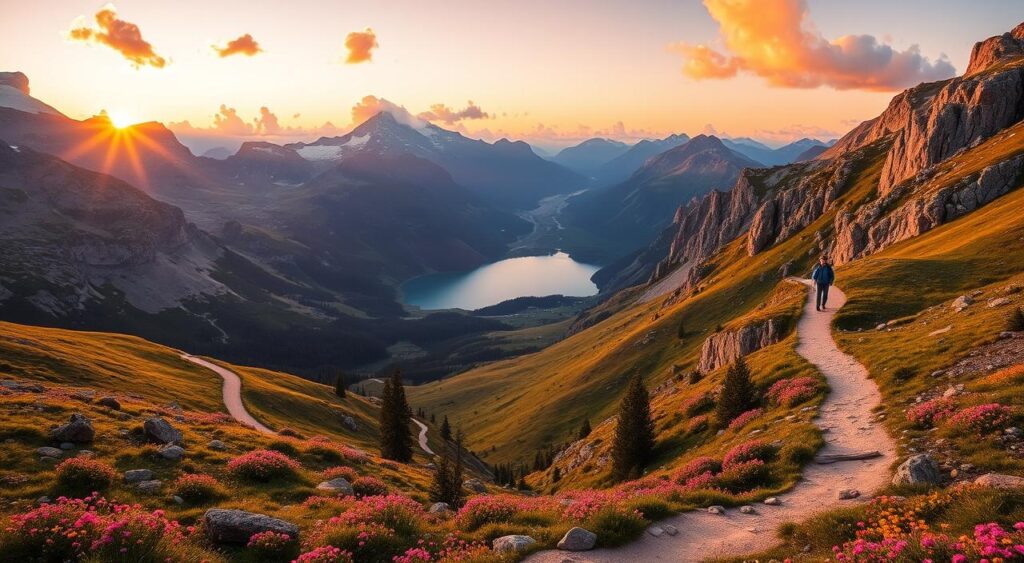
Driving the Going-to-the-Sun Road
Exploring Glacier National Park is an unforgettable experience. The Going-to-the-Sun Road is one of the park’s most iconic attractions. This 50-mile scenic drive offers breathtaking vistas of the park’s dramatic landscapes.
The peak season for driving the Going-to-the-Sun Road is between May 24 and September 8. During this time, visitors can fully appreciate the park’s natural beauty.
The road is fully accessible during peak season. However, the road’s high elevation can lead to early and late-season closures due to snow. Travelers should check the park’s road status page for updates on which areas are open.
One of the highlights of the Going-to-the-Sun Road is the Logan Pass. It stands at an impressive 6,646 feet (2,026 m). Visitors should be prepared for cooler temperatures at the higher elevations.
It is recommended to dress in layers to accommodate the highly variable weather conditions in Glacier National Park. The Going-to-the-Sun Road offers numerous pullouts and viewpoints. Visitors can stop and take in the stunning scenery.
Wildlife sightings, such as mountain goats, bighorn sheep, and grizzly bears, are common along the route. With five campgrounds located directly on the Going-to-the-Sun Road, visitors have ample opportunities to immerse themselves in the park’s natural wonders.
To ensure a smooth experience, it is important to plan ahead when visiting Glacier National Park. The park has implemented a vehicle reservation system. Visitors must purchase timed entry tickets to access the Going-to-the-Sun Road during peak hours.
These tickets can be booked up to 120 days in advance or on a “Next Day” basis, with limited availability. Visitors should also be prepared for potential crowds. The Logan Pass parking lot is often full between 9:30 a.m. and 4 p.m.
Overall, the Going-to-the-Sun Road is a must-see attraction in Glacier National Park. It offers unparalleled views, wildlife sightings, and opportunities to explore the park’s diverse landscapes. With careful planning and a willingness to embrace the park’s variable weather conditions, visitors can create an unforgettable experience driving this iconic route.
Wildlife Viewing Opportunities
Glacier National Park is a paradise for wildlife lovers. It’s home to many species, from majestic moose and elk to mountain lions and wolves. Visitors can see these amazing animals in their natural habitats.
Fall is the best time to see wildlife here. Animals get ready for winter by being more active. You might see bighorn sheep and mountain goats on cliffs or a grizzly bear looking for food.
In spring and summer, the park comes alive. As snow melts and it gets warmer, animals wake up. You can see deer and elk in meadows or spot iconic animals in their natural setting.
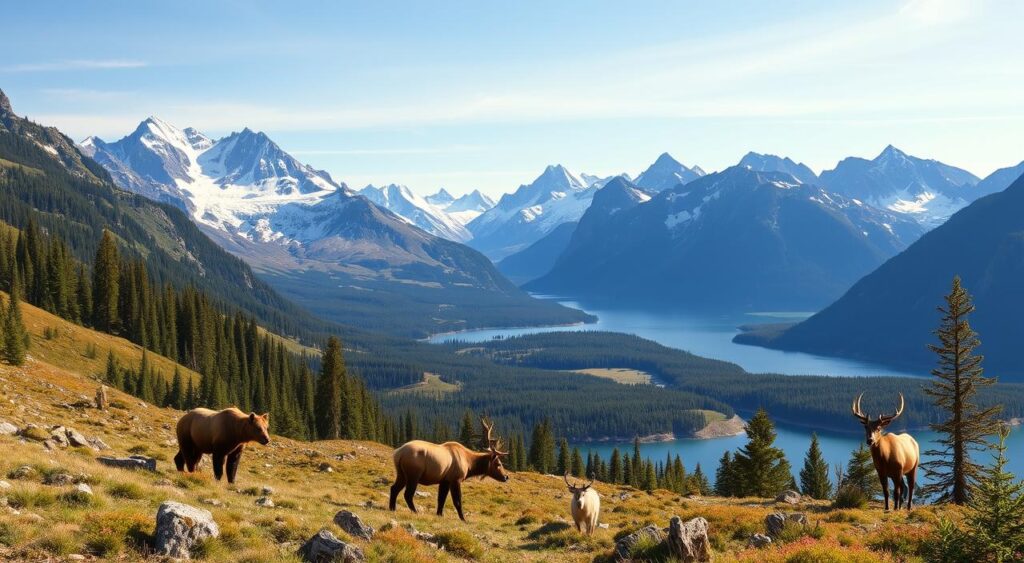
Glacier National Park is great for spotting wildlife like moose or coyotes. Bring your binoculars and camera. Get ready to explore the natural wonders of this incredible park.
Photography Highlights
Glacier National Park is a dream spot for photographers. It has towering peaks, clear alpine lakes, and colorful wildflowers. This makes it perfect for capturing stunning landscapes. If you want to see the northern lights, winter is the best time, especially from January to March.
Landscapes, Wildflowers, and Northern Lights
The best time to take photos of wildflowers and landscapes is from late June to mid-August. The weather is warm, and the flowers are in full bloom. You can take amazing pictures of the Going-to-the-Sun Road and the calm alpine lakes.
Winter is the best time to see the northern lights. There are fewer people, and the darkness is longer. This makes it easier to capture the beautiful aurora borealis.
Glacier National Park is a photographer’s dream. It has a wide range of subjects and natural beauty all year. Whether you’re taking pictures of landscapes, wildflowers, or the northern lights, you’ll get amazing and unforgettable shots.
Lodging and Services Availability
Visiting Glacier National Park means different things at different times of the year. In the summer, from late June to early September, everything is open. But as fall comes, many places start to close. By the end of September or early October, most are shut down.
Winter is the quietest time, with only a few services available. Some areas are off-limits, and hours for lodging and activities are cut. If you’re visiting in winter, expect a quiet, remote experience.
Glacier National Park has many places to stay, like motels and lodges. Apgar Village on Lake McDonald has the most options. Outside the park, private businesses offer more places to stay and eat, mainly in summer.
Planning your Glacier National Park trip? Remember, some places are only open at certain times. Book early, especially in summer, to get the best spot.
Weather Patterns and Preparation
Visiting Glacier National Park means you must watch the weather closely. The park’s location near the Continental Divide causes big temperature swings. Summer can be hot, with temperatures in the 90s, while winter gets very cold.
Summer temperatures near Lake McDonald are around 80 degrees. But, Logan Pass at higher elevations can be 10-15 degrees cooler.
Temperature Variations and Unpredictability
The weather in Glacier National Park changes quickly. July and August are usually dry, with little rain. But, May and June have more storms and snowmelt, making the climate lively.
Temperatures can drop a lot. Spring is in the mid-50s to low 70s. Summer is in the high 70s to low 80s, with cooler evenings. Fall starts in the high 60s in September and cools to the mid-50s by October.
Hikers face big elevation changes. The hike from Lake McDonald to Sperry Park Chalet goes up 3,360 feet. The Apgar Lookout is at 6,593 feet.
It’s key to dress right for Glacier National Park, no matter the season. Bring layers and rain gear. People from warmer places might forget to drink enough water. Locals often carry extra clothes or a “layers bag” for the weather changes.
The weather in Glacier National Park is always changing. It can rain suddenly and get very cold with elevation. Knowing and preparing for this weather is vital for a safe and fun visit to this beautiful place.
Cost Considerations
Visiting Glacier National Park can be pricey, but there are ways to save money. The main cost factor is when you go. Prices for lodging, flights, and cars are highest in July and August because of the crowds.
Peak Season vs. Shoulder Season Pricing
But, visiting in spring or fall can be cheaper. You’ll find lower prices on accommodations, transport, and park fees. Plus, Glacier offers cheaper entrance fees in winter, making it a budget-friendly time to see the park.
The Standard Entrance Pass costs between $20.00 and $35.00. The Annual Entrance Pass is $70.00. There’s also the America the Beautiful Annual Pass for $80.00. Seniors and military get discounts, with passes starting at $20.00.
Planning well can help you enjoy Glacier National Park without spending too much. Think about transportation, where you stay, and what you do. By choosing the right time, you can save money and still have a great trip.
Conclusion
Figuring out the best time to visit Glacier National Park depends on what you want to do and see. Summer brings warm days and sunny skies. Winter offers quiet and snow-covered trails. Think about the weather, crowds, how easy it is to get around, and the cost to find the perfect trip for you.
Glacier National Park is great any time of year. Summer is busy, but you’ll see everything in bloom. Autumn brings beautiful colors. Winter is peaceful, with snow all around. No matter when you go, you’ll find amazing views, wildlife, and outdoor fun.
Start planning your Glacier National Park trip now. Get ready to see the stunning beauty and endless adventures this park offers.
FAQ
What are the best times of year to visit Glacier National Park?
Glacier National Park is great to visit all year round. Summer is the busiest time, with warm weather and open trails. Fall offers beautiful leaves and fewer people. Winter is quiet and snowy. Spring is perfect for biking on the Going-to-the-Sun Road before it opens.
What is the weather like in Glacier National Park throughout the year?
The weather in Glacier National Park changes quickly. Summers are warm, with temperatures in the 60s to 80s. Winters are cold, often below freezing. The park’s location near the Continental Divide causes big weather differences between the east and west sides.
How accessible are the hiking trails in Glacier National Park during different seasons?
Hiking trails in Glacier National Park vary by season. In summer, most trails are open and clear. Spring and fall trails may have snow or mud. Winter trails are hard to navigate due to deep snow.
When is the best time to drive the Going-to-the-Sun Road in Glacier National Park?
The Going-to-the-Sun Road is open from early July to early October. It offers stunning views and pullouts. But, it closes early and late due to snow, so check the timing.
What are the best opportunities for wildlife viewing in Glacier National Park?
Glacier National Park is full of wildlife like moose, elk, and bears. Fall is the best time to see them as they prepare for winter. Spring and summer are also good for spotting wildlife.
When is the best time to photograph Glacier National Park?
Glacier National Park is a photographer’s dream. The best time for landscapes and wildflowers is late June to mid-August. For northern lights, visit from January to March.
How do the costs of visiting Glacier National Park vary by season?
Visiting Glacier National Park costs vary by season. Summer is the most expensive due to high demand. Spring and fall are cheaper, with lower park entrance fees in winter.

